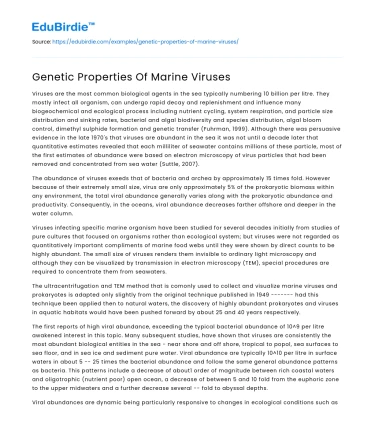Viruses are the most common biological agents in the sea typically numbering 10 billion per litre. They mostly infect all organism, can undergo rapid decay and replenishment and influence many biogeochemical and ecological process including nutrient cycling, system respiration, and particle size distribution and sinking rates, bacterial and algal biodiversity and species distribution, algal bloom control, dimethyl sulphide formation and genetic transfer (Fuhrman, 1999). Although there was persuasive evidence in the late 1970's that viruses are abundant in the sea it was not until a decade later that quantitative estimates revealed that each milliliter of seawater contains millions of these particle, most of the first estimates of abundance were based on electron microscopy of virus particles that had been removed and concentrated from sea water (Suttle, 2007).
The abundance of viruses exeeds that of bacteria and archea by approximately 15 times fold. However because of their extremely small size, virus are only approximately 5% of the prokaryotic biomass within any environment, the total viral abundance generally varies along with the prokaryotic abundance and productivity. Consequently, in the oceans, viral abundance decreases farther offshore and deeper in the water column.
Save your time!
We can take care of your essay
- Proper editing and formatting
- Free revision, title page, and bibliography
- Flexible prices and money-back guarantee
Viruses infecting specific marine organism have been studied for several decades initially from studies of pure cultures that focused on organisms rather than ecological system; but viruses were not regarded as quantitatively important compliments of marine food webs until they were shown by direct counts to be highly abundant. The small size of viruses renders them invisible to ordinary light microscopy and although they can be visualized by transmission in electron microscopy (TEM), special procedures are required to concentrate them from seawaters.
The ultracentrifugation and TEM method that is comonly used to collect and visualize marine viruses and prokaryotes is adapted only slightly from the original technique published in 1949 ------- had this technique been applied then to natural waters, the discovery of highly abundant prokaryotes and viruses in aquatic habitats would have been pushed forward by about 25 and 40 years respectively.
The first reports of high viral abundance, exceeding the typical bacterial abundance of 10^9 per litre awakened interest in this topic. Many subsequent studies, have shown that viruses are consistently the most abundant biological entities in the sea - near shore and off shore, tropical to popol, sea surfaces to sea floor, and in sea ice and sediment pure water. Viral abundance are typically 10^10 per litre in surface waters in about 5 -- 25 times the bacterial abundance and follow the same general abundance patterns as bacteria. This patterns include a decrease of about1 order of magnitude between rich coastal waters and oligotrophic (nutrient poor) open ocean, a decrease of between 5 and 10 fold from the euphoric zone to the upper midwaters and a further decrease several -- fold to abyssal depths.
Viral abundances are dynamic being particularly responsive to changes in ecological conditions such as algal blooms, this provides strong evidence are active member of the community rather than inert particles.
Pronounced fluctuations in virus abundance over timescales of minutes to hours maybe indicative of synchronized host - cell lysis and rapid degration of a large portion of progeny viruses. On scales of hundreds of kilometers, viruses abundance is usually strongly correlated to bacterial abundance and less so to particulate chlorophyll indicating that most marine viruses infects bacteria.






 Stuck on your essay?
Stuck on your essay?

